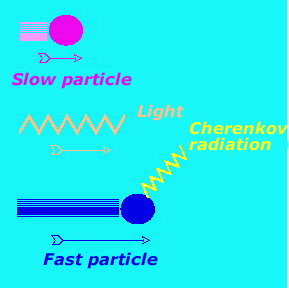
Windows to the Universe original image
The Cherenkov Effect
The theory of relativity states that no particle can travel at the speed of light in a vacuum. However, light travels at lower speeds in dense media, like water. A particle traveling in water must have a speed less than the speed of light in a vacuum, but it is possible for it to move faster than the speed of light in water. If the particle is charged, it will emit radiation (light). This process is similar to the sonic boom heard when an airplane exceeds the speed of sound. Neutrino interactions with water can produce such particles. Sensitive light detectors measure this Cherenkov radiation in Neutrino experiments.
This material is considered too complex to be written about at an intermediate or beginner level, so all levels appear in the advanced form.







